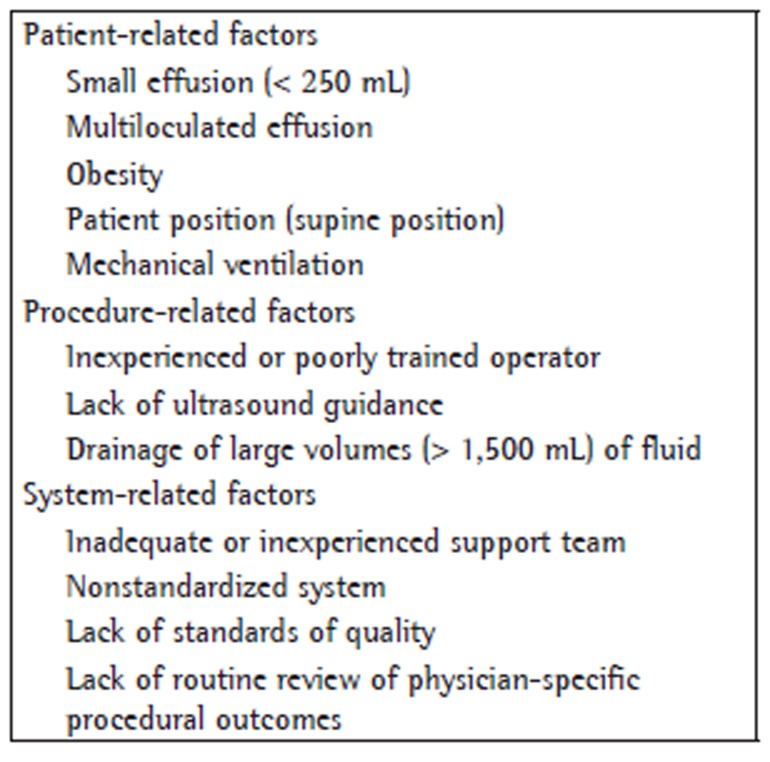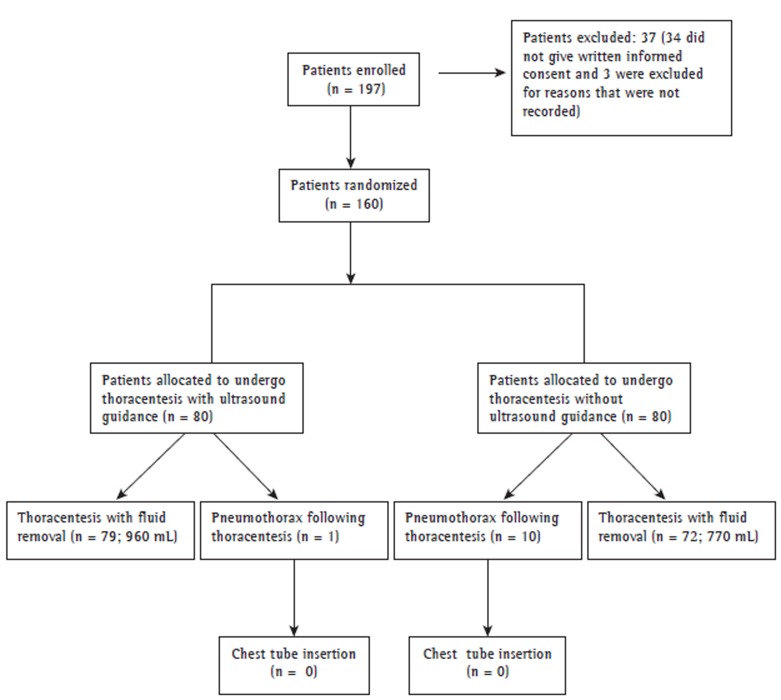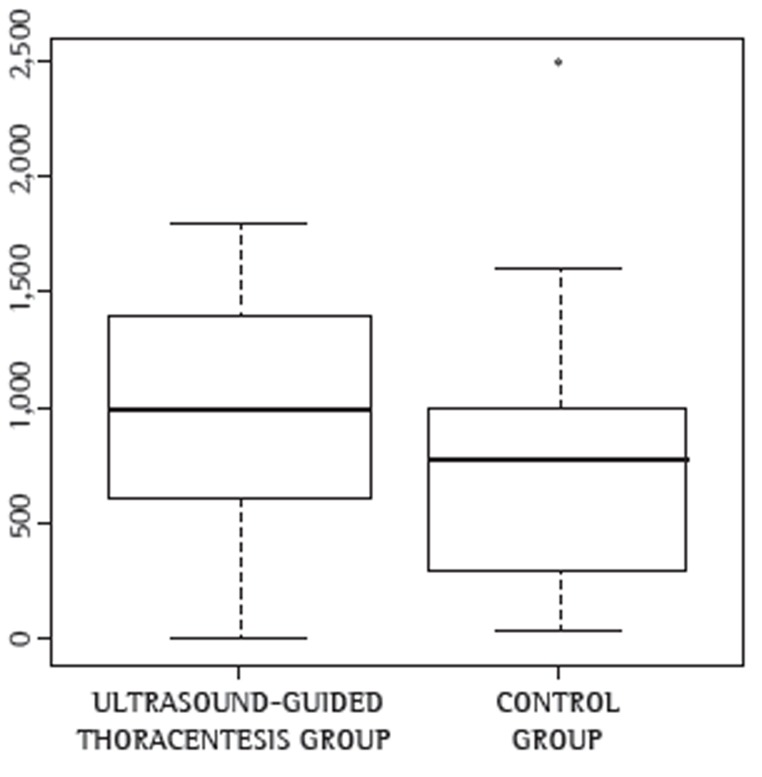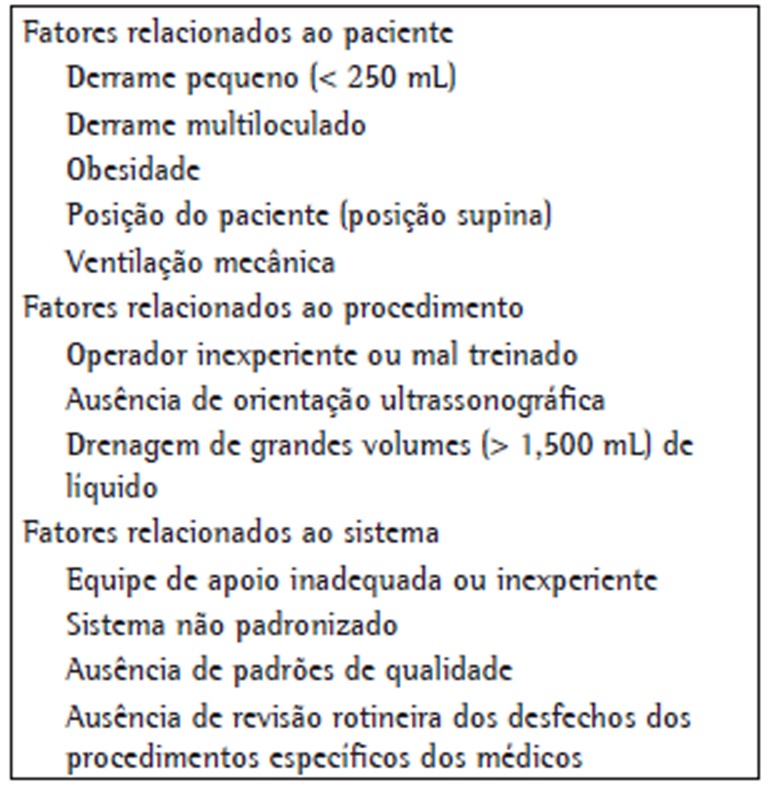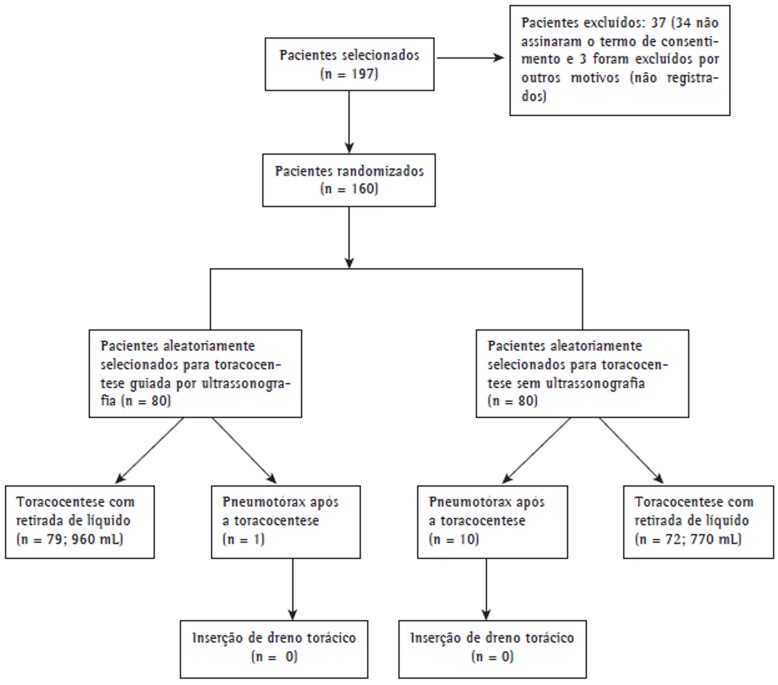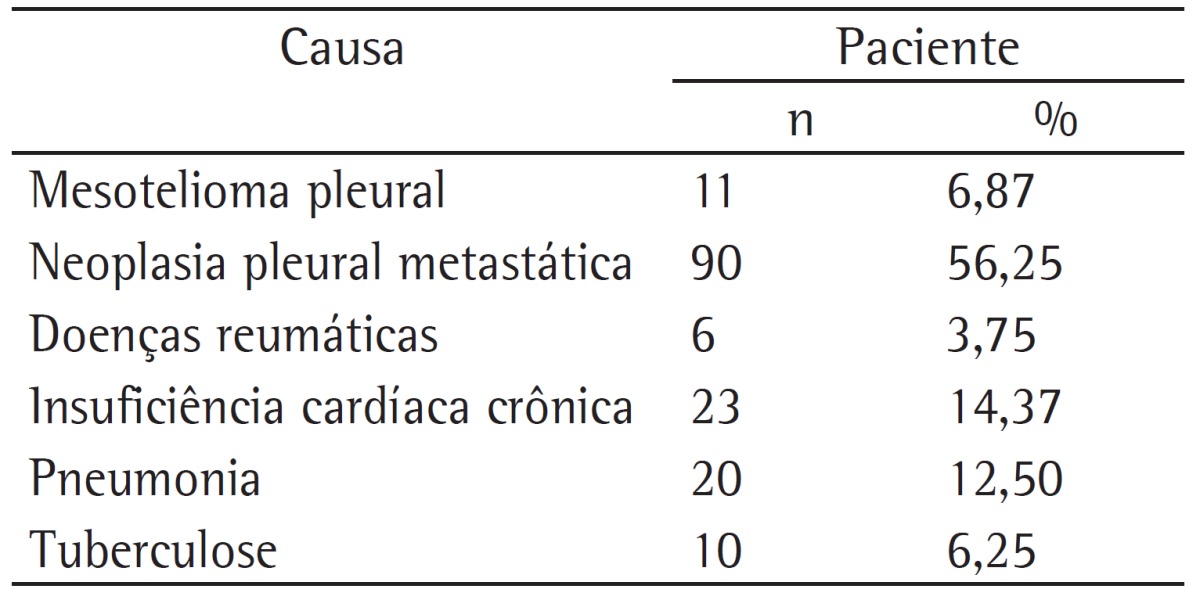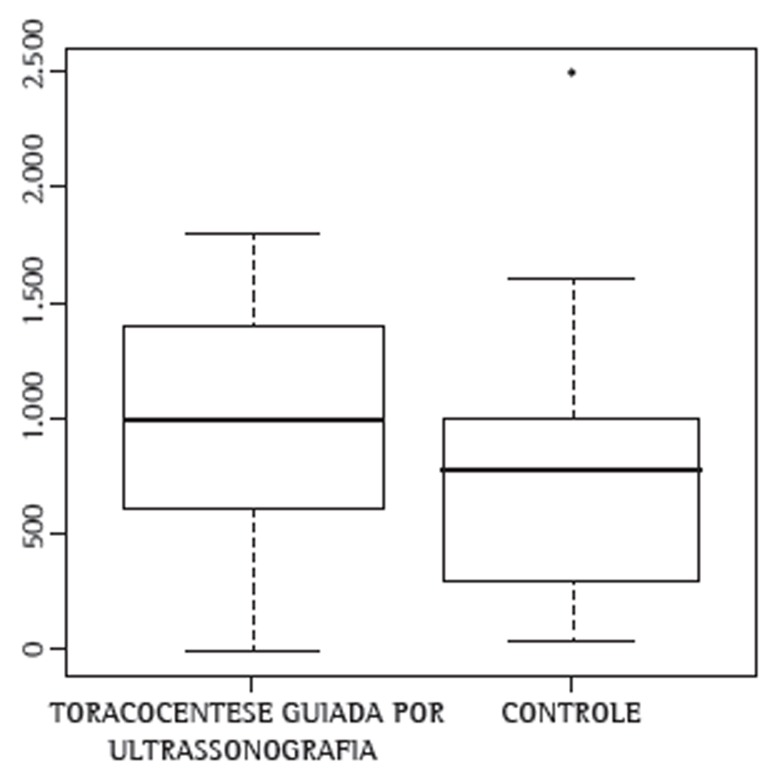Abstract
OBJECTIVE:
Thoracentesis is one of the bedside procedures most commonly associated with iatrogenic complications, particularly pneumothorax. Various risk factors for complications associated with thoracentesis have recently been identified, including an inexperienced operator; an inadequate or inexperienced support team; the lack of a standardized protocol; and the lack of ultrasound guidance. We sought to determine whether ultrasound-guided thoracentesis can reduce the risk of pneumothorax and improve outcomes (fewer procedures without fluid removal and greater volumes of fluid removed during the procedures). In our comparison of thoracentesis with and without ultrasound guidance, all procedures were performed by a team of expert pulmonologists, using the same standardized protocol in both conditions.
METHODS:
A total of 160 participants were randomly allocated to undergo thoracentesis with or without ultrasound guidance (n = 80 per group). The primary outcome was pneumothorax following thoracentesis. Secondary outcomes included the number of procedures without fluid removal and the volume of fluid drained during the procedure.
RESULTS:
Pneumothorax occurred in 1 of the 80 patients who underwent ultrasound-guided thoracentesis and in 10 of the 80 patients who underwent thoracentesis without ultrasound guidance, the difference being statistically significant (p = 0.009). Fluid was removed in 79 of the 80 procedures performed with ultrasound guidance and in 72 of the 80 procedures performed without it. The mean volume of fluid drained was larger during the former than during the latter (960 ± 500 mL vs. 770 ± 480 mL), the difference being statistically significant (p = 0.03).
CONCLUSIONS:
Ultrasound guidance increases the yield of thoracentesis and reduces the risk of post-procedure pneumothorax. (Chinese Clinical Trial Registry identifier: ChiCTR-TRC-12002174 [http://www.chictr.org/en/])
Keywords: Pneumothorax, Ultrasonography, Thoracic surgical procedures
Introduction
In the United States, pleural effusion is diagnosed in approximately 1.5 million patients each year, and therapeutic thoracentesis is therefore a common medical procedure.(1) In addition, thoracentesis is one of the bedside procedures most commonly associated with iatrogenic complications, particularly pneumothorax.(2) A systematic review and meta-analysis of 24 studies, including a total of 6,605 thoracenteses, showed a 6.0% overall incidence of pneumothorax, one third of the cases of pneumothorax requiring chest tube insertion.(2)
The safety of thoracentesis has been directly associated with the technical skills of the operator. (2) Within the past several years, system and procedural variables, including a lack of real-time ultrasound imaging, operator inexperience, drainage of large volumes of fluid, and repeated thoracentesis, have been shown to increase the likelihood of complications.(2-4) An optimal thoracentesis protocol should include the use of the best available techniques (in order to minimize procedural errors and complications) in combination with a system that improves the technical skills of the operator.(1,5) Various risk factors for complications associated with thoracentesis (particularly pneumothorax) were described in a recent study(5) and are displayed in Chart 1. Those risk factors include an inexperienced or poorly trained operator, an inadequate or inexperienced support team, nonstandardized systems, and lack of ultrasound guidance.(2,5) In view of these considerations, we sought to determine whether ultrasound guidance reduces the risk of pneumothorax following thoracentesis.
Chart 1. Risk factors for complications associated with thoracentesis.
The primary outcome measure of the present study was to determine whether the incidence of pneumothorax following thoracentesis differed between two conditions: thoracentesis performed under ultrasound guidance by a team of expert pulmonologists (with 20 years of experience, specific physician training in the procedure, more than 500 thoracenteses performed, and training in chest ultrasound)(6) using a standardized protocol and standard equipment; and thoracentesis performed without ultrasound guidance by the same team using the same protocol and equipment. Secondary outcome measures included the number of procedures during which no fluid was removed, the volume of fluid removed during each procedure, and the need for chest tube placement.
Methods
This was a prospective randomized study conducted between May of 2012 and October of 2012, involving consecutive inpatients and outpatients with pleural effusion treated in the Department of Respiratory Diseases (respiratory monitoring section, respiratory ward, or day hospital) of the Sestri Levante General Hospital, in the municipality of Sestri Levante, Italy. The inclusion criteria were as follows: presenting with pleural effusion visible on chest X-rays and requiring pleural puncture (diagnostic or therapeutic thoracentesis) on the basis of previously published criteria(7); and being in the 18-85 year age bracket. We enrolled a total of 197 patients with pleural effusion due to various causes, including neoplasms, chronic heart failure, rheumatic diseases, pneumonia, and tuberculosis. Of those 197 patients, 34 declined to participate and 3 were excluded for other reasons (not recorded). Therefore, 160 patients were randomly allocated to undergo thoracentesis with ultrasound guidance (ultrasound-guided thoracentesis group) or without ultrasound guidance (control group). A flowchart of the study is shown in Figure 1.
Figure 1. Flowchart of the study.
A statistician who was not involved in the present study devised a randomization plan using a computerized random number generator. The randomization plan was given to each recruiting physician in a sealed envelope. The patients underwent thoracentesis with or without ultrasound guidance on the basis of the randomization plan. Ultrasound was not used for real-time guidance; rather, it was used immediately before the procedure in order to identify the appropriate site. Thoracentesis was performed immediately after the site had been marked. We employed a portable ultrasound system (LOGIQ P5; GE Healthcare, Chalfont, UK) with a convex probe (3.5-5.0 MHz).
Thoracentesis was performed by one of three pulmonologists, with the patient in the sitting position, following a local protocol written in accordance with the 2010 British Thoracic Society Pleural Disease Guideline.(5) In addition, we used a thoracentesis set (Chimed s.r.l., Livorno, Italy) consisting of a three-way stopcock, a large (60-mL) syringe, a 2,000-mL vacuum-free collection bag, and a 50-mm, 18-G needle. Fluid was drained either by passive drainage or by active drainage with the 60-mL syringe connected to the three-way stopcock.
Fluid removal was terminated when there was chest pain, excessive cough, a vasovagal event, shortness of breath, or air suction. Drainage was stopped when 1.5 L of pleural fluid had been removed. Within 60 min after the procedure, posteroanterior and lateral decubitus chest X-rays were performed. The occurrence of pneumothorax was determined on the basis of the British Thoracic Society guidelines.(8) The investigators involved in the analysis of the data were blinded to the complications. The primary outcome measure of the present study was the incidence of pneumothorax following thoracentesis. Secondary outcome measures included the need for chest tube drainage and the volume of fluid drained. The study was conducted in accordance with the Declaration of Helsinki and was approved by the Research Ethics Committee of Azienda Sanitaria Locale no. 4 Chiavarese, Liguria, Italy. All participating patients gave written informed consent.
The main objectives of the present study were to compare the incidence of pneumothorax following thoracentesis performed under ultrasound guidance with that of pneumothorax following thoracentesis performed without ultrasound guidance and to determine the diagnostic value (i.e., the number of procedures during which fluid was removed and the volume of fluid removed) of ultrasound-guided thoracentesis. We used logistic regression for categorical variables (incidence of pneumothorax and secondary outcomes of thoracentesis) and analysis of covariance for continuous variables. All data were analyzed with the R software, version 2.13.2 (The R Foundation for Statistical Computing, Vienna, Austria). Values of p < 0.05 were considered statistically significant.
Results
All 160 patients evaluated (122 males and 38 females) completed the study. All of the patients were in the 32-84 year age bracket (mean age, 67.8 ± 14.9 years).
The causes of pleural effusion were as follows: pleural mesothelioma, in 11 patients; metastatic pleural neoplasm, in 90 patients; rheumatic disease, in 6 patients; chronic heart failure, in 23 patients; pneumonia, in 20 patients; and tuberculosis, in 10 patients (Table 1). A total of 80 thoracenteses were performed without ultrasound guidance. Of those, 8 were suspended because of complications: chest pain (in 4); air suction (in 3); and excessive cough with dyspnea (in 1). Of the 80 thoracenteses performed under ultrasound guidance, only 1 was suspended (because of chest pain and shortness of breath).
Table 1. Causes of pleural effusion in the 160 patients under study.

Pneumothorax following thoracentesis occurred in 1 of the 80 patients submitted to the procedure performed under ultrasound guidance and in 10 of the 80 patients submitted to the procedure performed without ultrasound guidance, the difference being statistically significant (p = 0.009). None of the 11 cases of pneumothorax required chest tube placement.
As can be seen in Table 2, 79 of the 80 ultrasound-guided procedures were successful, as were 72 of the 80 procedures performed without ultrasound guidance. As can be seen in Figure 2, the mean volume of fluid drained during the former procedures was larger than was that drained during the latter procedures (960 ± 500 mL vs. 770 ± 480 mL), the difference being statistically significant (p = 0.03).
Table 2. Patient data and results (including statistics) in the patients submitted to thoracentesis performed under ultrasound guidance (the ultrasound-guided thoracentesis group) and in those submitted to thoracentesis performed without ultrasound guidance (the control group).

Figure 2. Mean volume of pleural fluid removed during thoracentesis in the patients who underwent the procedure performed under ultrasound guidance (ultrasound-guided thoracentesis group) and in those who underwent the procedure performed without ultrasound guidance (control group). The difference between the two groups was statistically significant (p = 0.014).
In 8 of the patients in the control group, no fluid was removed during the procedure. An ultrasound-guided thoracentesis was performed in 4 of those 8 patients, pleural fluid being successfully removed (240 ± 30 mL).
The probability of success (i.e., fluid removal) was approximately nine times higher in the patients who underwent ultrasound-guided thoracentesis than in those who underwent thoracentesis without ultrasound guidance (OR = 8.8). In addition, the risk of pneumothorax was 90% lower in the former than in the latter (OR = 0.09). Patient data and the results are reported in Table 2.
Discussion
The purpose of the present study was to determine whether the incidence of pneumothorax following thoracentesis decreases when most of the risk factors (mechanical ventilation use, an inexperienced team, and an inexperienced operator) are absent and ultrasound guidance is used. We have demonstrated that ultrasound-guided thoracentesis is a very safe procedure, which was associated with a very low (1.25%) incidence of pneumothorax in our sample (1 case among the 80 patients in the ultrasound-guided thoracentesis group). In fact, ultrasound guidance reduced the risk of pneumothorax by 90% (OR = 0.09; 95% CI: 0.005-0.5; p = 0.009). Although there was no difference between the two groups in terms of the need for chest tube drainage, the amount of fluid drained was significantly greater in the ultrasound-guided thoracentesis group than in the control group (p = 0.0014).
The strength of the present study lies in the fact that it was performed by skilled pulmonologists using carefully standardized procedures to evaluate the benefit of ultrasound guidance without any bias. To our knowledge, this is the first study of its kind. We are aware of the limitations of our study, which include the fact that patients on mechanical ventilation were not enrolled and the fact that real-time ultrasound guidance was not performed (ultrasound being used only to mark the site before thoracentesis was performed). Real-time ultrasound guidance allows clinicians to visualize the needle and important adjacent structures and therefore avoid accidental punctures, as well as allowing a further reduction in the risk of pneumothorax following thoracentesis. Nevertheless, its routine use at the bedside remains low, although it is considered the standard of care in safely locating, characterizing, and draining pleural fluid. Ultrasound is highly sensitive for detecting pleural effusions, even when chest X-rays are normal. Chest X-rays can miss up to 500 mL of pleural effusion in cases of interlobar and loculated pleural effusion. Lung ultrasound can detect as little as 20 mL of pleural fluid, whereas an upright posteroanterior chest X-ray cannot detect blunting of the costophrenic angle unless there is at least 100 mL of fluid.(6,9) Ultrasound-guided thoracentesis has been associated with lower total hospital costs and a lower incidence of pneumothorax and hemorrhage.(9) The overall incidence of pneumothorax varies from 4.0% to 30.3%,(10,11) and chest tube insertion is required in 1.7% of all thoracenteses, in order to evacuate symptomatic pneumothoraces; therefore, 20-50% of all pneumothoraces following thoracentesis require chest tube insertion.(2,11) The reported incidence of pneumothorax is significantly lower in studies published after 2000 than in earlier studies (4.6% vs. 8.7%).(11,12)
There are four reasons why pneumothorax develops in patients undergoing thoracentesis. First, air can flow from the atmosphere into the pleural space, as occurs when the negative pressure of the pleural space communicates freely with the atmosphere. This most often occurs as the syringe is removed from a needle or catheter, particularly when the individual performing the procedure is inexperienced.(10) Second, the thoracentesis needle can lacerate the lung and allow air to enter the pleural space from the alveoli.(10,11) Third, the decrease in pleural pressure can lead to a rupture of the visceral pleura. (10,11) Fourth, trapped lung or lung entrapment develops as a result of transitory pleuropulmonary fistula. (10,11) Multiple risk factors for pneumothorax following thoracentesis have been identified, including the type of needle used,(11,13-15) operator inexperience,(16,17) the presence of emphysema,(11,18) having previously undergone thoracentesis,(19) being on mechanical ventilation,(20,21) and even the lack of ultrasound guidance.(10,22) The training of chest ultrasound technicians is task-specific and is aimed at developing the skill of identifying pleural fluid and surrounding organs, as well as that of providing an unobstructed view of the pleural fluid. These simple and well-defined skills can be readily acquired by pulmonologists and can avoid other complications during most thoracentesis procedures.(23,24) In addition, ultrasound-guided thoracentesis is a procedure that most pulmonologists can perform after short-term training.(23-25) We believe that meticulous adherence to sonographic criteria and avoidance of patient movement during the time elapsed between ultrasound examination and fluid removal are key factors responsible for the low rate of pneumothorax following thoracentesis and the larger volume of fluid removed during the procedure.(12,22-24)
In conclusion, ultrasound guidance can increase patient safety and the amount of fluid removed during thoracentesis. Ultrasonography is an easily learned technique that not only enhances the physical examination but also has the distinct advantage of being a portable imaging technique for the evaluation of the pleural space. Ultrasound is currently used in a limited number of thoracenteses, and the present study provides evidence supporting the more widespread use of this technique.(25)
Acknowledgments
We are grateful to the nursing staff of the Sestri Levante General Hospital Department of Pulmonology for providing outstanding care to the patients evaluated during the study period.
Footnotes
Study carried out in the Department of Respiratory Diseases, Sestri Levante General Hospital, Sestri Levante, Italy.
A versão completa em português deste artigo está disponível em www.jornaldepneumologia.com.br
Contributor Information
Alessandro Perazzo, Department of Respiratory Diseases, Sestri Levante General Hospital, Sestri Levante, Italy.
Piergiorgio Gatto, Department of Respiratory Diseases, Sestri Levante General Hospital, Sestri Levante, Italy.
Cornelius Barlascini, Department of Forensic Medicine, ASL4, Chiavarese, Italy.
Maura Ferrari-Bravo, Department of Public Health, ASL4, Chiavarese, Italy.
Antonello Nicolini, Department of Respiratory Diseases, Sestri Levante General Hospital, Sestri Levante, Italy.
References
- 1.Light RW. Clinical practice. Pleural effusion. N Engl J Med. 2002;346(25):1971–1977. doi: 10.1056/NEJMcp010731. http://dx.doi.org/10.1056/NEJMcp010731 [DOI] [PubMed] [Google Scholar]
- 2.Daniels CE, Ryu JH. Improving the safety of thoracentesis. Curr Opin Pulm Med. 2011;17(4):232–236. doi: 10.1097/MCP.0b013e328345160b. http://dx.doi.org/10.1097/MCP.0b013e328345160b [DOI] [PubMed] [Google Scholar]
- 3.Gordon CE, Feller-Kopman D, Balk EM, Smetana GW. Pneumothorax following thoracentesis: a systematic review and meta-analysis. Arch Intern Med. 2010;170(4):332–339. doi: 10.1001/archinternmed.2009.548. http://dx.doi.org/10.1001/archinternmed.2009.548 [DOI] [PubMed] [Google Scholar]
- 4.Duncan DR, Morgenthaler TI, Ryu JH, Daniels CE. Reducing iatrogenic risk in thoracentesis: establishing best practice via experiential training in a zero-risk environment. Chest. 2009;135(5):1315–1320. doi: 10.1378/chest.08-1227. http://dx.doi.org/10.1378/chest.08-1227 [DOI] [PubMed] [Google Scholar]
- 5.Havelock T, Teoh R, Laws D, Gleeson F, BTS Pleural Disease Guideline Group Pleural procedures and thoracic ultrasound: British Thoracic Society Pleural Disease Guideline 2010. Thorax. 2010;65 Suppl 2:ii61–ii76. doi: 10.1136/thx.2010.137026. http://dx.doi.org/10.1136/thx.2010.137026 [DOI] [PubMed] [Google Scholar]
- 6.Rahman NM, Singanayagam A, Davies HE, Wrightson JM, Mishra EK, Lee YC, et al. Diagnostic accuracy, safety and utilisation of respiratory physician-delivered thoracic ultrasound. Thorax. 2010;65(5):449–453. doi: 10.1136/thx.2009.128496. http://dx.doi.org/10.1136/thx.2009.128496 [DOI] [PubMed] [Google Scholar]
- 7.Villena Garrido V, Ferrer Sancho J, Hernández Blasco L, de Pablo Gafas A, Pérez Rodríguez E, Rodríguez Panadero F, et al. Diagnosis and treatment of pleural effusion [Article in Spanish] Arch Bronconeumol. 2006;42(7):349–372. doi: 10.1016/s1579-2129(06)60545-4. http://dx.doi.org/10.1157/13090586 [DOI] [PubMed] [Google Scholar]
- 8.MacDuff A, Arnold A, Harvey J, BTS Pleural Disease Guideline Group Management of spontaneous pneumothorax: British Thoracic Society Pleural Disease Guideline 2010. Thorax. 2010;65 Suppl 2:ii18–ii31. doi: 10.1136/thx.2010.136986. http://dx.doi.org/10.1136/thx.2010.136986 [DOI] [PubMed] [Google Scholar]
- 9.Turner JP, Dankoff J. Thoracic ultrasound. Emerg Med Clin North Am. 2012;30(2):451-73, ix. doi: 10.1016/j.emc.2011.12.003. http://dx.doi.org/10.1016/j.emc.2011.12.003 [DOI] [PubMed] [Google Scholar]
- 10.Patel PA, Ernst FR, Gunnarsson CL. Ultrasonography guidance reduces complications and costs associated with thoracentesis procedures. J Clin Ultrasound. 2012;40(3):135–141. doi: 10.1002/jcu.20884. http://dx.doi.org/10.1002/jcu.20884 [DOI] [PubMed] [Google Scholar]
- 11.Jones PW, Moyers JP, Rogers JT, Rodriguez RM, Lee YC, Light RW. Ultrasound-guided thoracentesis: is it a safer method? Chest. 2003;123(2):418–423. doi: 10.1378/chest.123.2.418. http://dx.doi.org/10.1378/chest.123.2.418 [DOI] [PubMed] [Google Scholar]
- 12.Gordon CE, Feller-Kopman D, Balk EM, Smetana GW. Pneumothorax following thoracentesis: a systematic review and meta-analysis. Arch Intern Med. 2010;170(4):332–339. doi: 10.1001/archinternmed.2009.548. http://dx.doi.org/10.1001/archinternmed.2009.548 [DOI] [PubMed] [Google Scholar]
- 13.Gervais DA, Petersein A, Lee MJ, Hahn PF, Saini S, Mueller PR. US-guided thoracentesis: requirement for postprocedure chest radiography in patients who receive mechanical ventilation versus patients who breathe spontaneously. Radiology. 1997;204(2):503–506. doi: 10.1148/radiology.204.2.9240544. [DOI] [PubMed] [Google Scholar]
- 14.Jenkins DW Jr, McKinney MK, Szpak MW, Booker JL Jr. Veres needle in the pleural space. South Med J. 1983;76(11):1383–1385. doi: 10.1097/00007611-198311000-00014. http://dx.doi.org/10.1097/00007611-198311000-00014 [DOI] [PubMed] [Google Scholar]
- 15.Khorasani A, Appavu SK, Nader AM, Saatee S. Tuohy needle and loss of resistance technique: a safer approach for thoracentesis. Anesthesiology. 1999;90(1):339–340. doi: 10.1097/00000542-199901000-00072. http://dx.doi.org/10.1097/00000542-199901000-00072 [DOI] [PubMed] [Google Scholar]
- 16.Collins TR, Sahn SA. Thoracocentesis Clinical value, complications, technical problems, and patient experience. Chest. 1987;91(6):817–822. doi: 10.1378/chest.91.6.817. http://dx.doi.org/10.1378/chest.91.6.817 [DOI] [PubMed] [Google Scholar]
- 17.Bartter T, Mayo PD, Pratter MR, Santarelli RJ, Leeds WM, Akers SM. Lower risk and higher yield for thoracentesis when performed by experienced operators. Chest. 1993;103(6):1873–1876. doi: 10.1378/chest.103.6.1873. http://dx.doi.org/10.1378/chest.103.6.1873 [DOI] [PubMed] [Google Scholar]
- 18.Brandstetter RD, Karetzky M, Rastogi R, Lolis JD. Pneumothorax after thoracentesis in chronic obstructive pulmonary disease. Heart Lung. 1994;23(1):67–70. [PubMed] [Google Scholar]
- 19.Colt HG, Brewer N, Barbur E. Evaluation of patient-related and procedure-related factors contributing to pneumothorax following thoracentesis. Chest. 1999;116(1):134–138. doi: 10.1378/chest.116.1.134. http://dx.doi.org/10.1378/chest.116.1.134 [DOI] [PubMed] [Google Scholar]
- 20.Lichtenstein D, Hulot JS, Rabiller A, Tostivint I, Mezière G. Feasibility and safety of ultrasound-aided thoracentesis in mechanically ventilated patients. Intensive Care Med. 1999;25(9):955–958. doi: 10.1007/s001340050988. http://dx.doi.org/10.1007/s001340050988 [DOI] [PubMed] [Google Scholar]
- 21.Mayo PH, Goltz HR, Tafreshi M, Doelken P. Safety of ultrasound-guided thoracentesis in patients receiving mechanical ventilation. Chest. 2004;125(3):1059–1062. doi: 10.1378/chest.125.3.1059. http://dx.doi.org/10.1378/chest.125.3.1059 [DOI] [PubMed] [Google Scholar]
- 22.Petersen WG, Zimmerman R. Limited utility of chest radiograph after thoracentesis. Chest. 2000;117(4):1038–1042. doi: 10.1378/chest.117.4.1038. http://dx.doi.org/10.1378/chest.117.4.1038 [DOI] [PubMed] [Google Scholar]
- 23.Tsang TS, Enriquez-Sarano M, Freeman WK, Barnes ME, Sinak LJ, Gersh BJ, et al. Consecutive 1127 therapeutic echocardiographically guided pericardiocenteses: clinical profile, practice patterns, and outcomes spanning 21 years. Mayo Clin Proc. 2002;77(5):429–436. doi: 10.4065/77.5.429. [DOI] [PubMed] [Google Scholar]
- 24.Soldati G, Smargiassi A, Inchingolo R, Sher S, Valente S, Corbo GM. Ultrasound-guided pleural puncture in supine or recumbent lateral position - feasibility study. Multidiscip Respir Med. 2013;8(1):18–18. doi: 10.1186/2049-6958-8-18. http://dx.doi.org/10.1186/2049-6958-8-18 [DOI] [PMC free article] [PubMed] [Google Scholar]
- 25.Mercaldi CJ, Lanes SF. Ultrasound guidance decreases complications and improves the cost of care among patients undergoing thoracentesis and paracentesis. Chest. 2013;143(2):532–538. doi: 10.1378/chest.12-0447. http://dx.doi.org/10.1378/chest.12-0447 [DOI] [PubMed] [Google Scholar]



